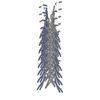+ Open data
Open data
- Basic information
Basic information
| Entry | Database: PDB / ID: 9ftm | |||||||||
|---|---|---|---|---|---|---|---|---|---|---|
| Title | Asgard ESCRT-IIIB membrane-bound protofilament structure | |||||||||
 Components Components | Heimdallarchaeota archaeon AB_125 ESCRT-IIIB | |||||||||
 Keywords Keywords | MEMBRANE PROTEIN / ESCRT-III / filament / membrane binding protein / membrane remodeling / Asgard archaea | |||||||||
| Function / homology | Snf7 family / Snf7 / late endosome to vacuole transport via multivesicular body sorting pathway / vesicle budding from membrane / endomembrane system / cytoplasmic side of plasma membrane / intracellular membrane-bounded organelle / Uncharacterized protein Function and homology information Function and homology information | |||||||||
| Biological species |  Candidatus Heimdallarchaeota archaeon (archaea) Candidatus Heimdallarchaeota archaeon (archaea) | |||||||||
| Method | ELECTRON MICROSCOPY / helical reconstruction / cryo EM / Resolution: 6.5 Å | |||||||||
 Authors Authors | Chaaban, S. / Souza, D.P. / Baum, B. | |||||||||
| Funding support |  United Kingdom, 2items United Kingdom, 2items
| |||||||||
 Citation Citation |  Journal: Sci Adv / Year: 2025 Journal: Sci Adv / Year: 2025Title: Asgard archaea reveal the conserved principles of ESCRT-III membrane remodeling. Authors: Diorge P Souza / Javier Espadas / Sami Chaaban / Edmund R R Moody / Tomoyuki Hatano / Mohan Balasubramanian / Tom A Williams / Aurélien Roux / Buzz Baum /   Abstract: ESCRT-III proteins assemble into composite polymers that undergo stepwise changes in composition and structure to deform membranes across the tree of life. Here, using a phylogenetic analysis, we ...ESCRT-III proteins assemble into composite polymers that undergo stepwise changes in composition and structure to deform membranes across the tree of life. Here, using a phylogenetic analysis, we demonstrate that the two endosomal sorting complex required for transport III (ESCRT-III) proteins present in eukaryote's closest Asgard archaeal relatives are evolutionarily related to the B- and A-type eukaryotic paralogs that initiate and execute membrane remodeling, respectively. We show that Asgard ESCRT-IIIB assembles into parallel arrays on planar membranes to initiate membrane deformation, from where it recruits ESCRT-IIIA to generate composite polymers. Last, we show that Asgard ESCRT-IIIA is able to remodel membranes into tubes as a likely prelude to scission. Together, these data reveal a set of conserved principles governing ESCRT-III-dependent membrane remodeling that first emerged in a two-component ESCRT-III system in archaea. | |||||||||
| History |
|
- Structure visualization
Structure visualization
| Structure viewer | Molecule:  Molmil Molmil Jmol/JSmol Jmol/JSmol |
|---|
- Downloads & links
Downloads & links
- Download
Download
| PDBx/mmCIF format |  9ftm.cif.gz 9ftm.cif.gz | 96.8 KB | Display |  PDBx/mmCIF format PDBx/mmCIF format |
|---|---|---|---|---|
| PDB format |  pdb9ftm.ent.gz pdb9ftm.ent.gz | 59.4 KB | Display |  PDB format PDB format |
| PDBx/mmJSON format |  9ftm.json.gz 9ftm.json.gz | Tree view |  PDBx/mmJSON format PDBx/mmJSON format | |
| Others |  Other downloads Other downloads |
-Validation report
| Arichive directory |  https://data.pdbj.org/pub/pdb/validation_reports/ft/9ftm https://data.pdbj.org/pub/pdb/validation_reports/ft/9ftm ftp://data.pdbj.org/pub/pdb/validation_reports/ft/9ftm ftp://data.pdbj.org/pub/pdb/validation_reports/ft/9ftm | HTTPS FTP |
|---|
-Related structure data
| Related structure data |  50749MC  9ftlC M: map data used to model this data C: citing same article ( |
|---|---|
| Similar structure data | Similarity search - Function & homology  F&H Search F&H Search |
- Links
Links
- Assembly
Assembly
| Deposited unit | 
|
|---|---|
| 1 |
|
- Components
Components
| #1: Protein | Mass: 24130.268 Da / Num. of mol.: 8 Source method: isolated from a genetically manipulated source Source: (gene. exp.)  Candidatus Heimdallarchaeota archaeon (archaea) Candidatus Heimdallarchaeota archaeon (archaea)Gene: HeimAB125_14020 / Production host:  Has protein modification | N | |
|---|
-Experimental details
-Experiment
| Experiment | Method: ELECTRON MICROSCOPY |
|---|---|
| EM experiment | Aggregation state: FILAMENT / 3D reconstruction method: helical reconstruction |
- Sample preparation
Sample preparation
| Component | Name: Membrane-bound Asgard ESCRT-IIIB protofilament array / Type: ORGANELLE OR CELLULAR COMPONENT / Entity ID: all / Source: NATURAL |
|---|---|
| Molecular weight | Value: 33 kDa/nm / Experimental value: NO |
| Source (natural) | Organism:  Candidatus Heimdallarchaeota archaeon (archaea) Candidatus Heimdallarchaeota archaeon (archaea) |
| Buffer solution | pH: 6 Details: 20 mM Bis-Tris-HCl pH 6.0, 0.12 mM 1,2-dioleoyl-sn-glycero-3-phosphocholine, 0.08 mM 1,2-dioleoyl-sn-glycero-3-phospho-L-serine |
| Buffer component | Conc.: 20 mM / Name: Bis-Tris-HCl / Formula: Bis-Tris-HCl |
| Specimen | Conc.: 0.5 mg/ml / Embedding applied: NO / Shadowing applied: NO / Staining applied: NO / Vitrification applied: YES |
| Specimen support | Grid material: GOLD / Grid mesh size: 300 divisions/in. / Grid type: Quantifoil R1.2/1.3 |
| Vitrification | Instrument: FEI VITROBOT MARK IV / Cryogen name: ETHANE / Humidity: 95 % / Chamber temperature: 293.15 K |
- Electron microscopy imaging
Electron microscopy imaging
| Experimental equipment |  Model: Titan Krios / Image courtesy: FEI Company |
|---|---|
| Microscopy | Model: FEI TITAN KRIOS |
| Electron gun | Electron source:  FIELD EMISSION GUN / Accelerating voltage: 300 kV / Illumination mode: FLOOD BEAM FIELD EMISSION GUN / Accelerating voltage: 300 kV / Illumination mode: FLOOD BEAM |
| Electron lens | Mode: BRIGHT FIELD / Nominal defocus max: 2600 nm / Nominal defocus min: 600 nm |
| Image recording | Electron dose: 50 e/Å2 / Film or detector model: GATAN K3 BIOQUANTUM (6k x 4k) / Num. of real images: 29600 |
- Processing
Processing
| EM software |
| ||||||||||||||||||||||||||||||||
|---|---|---|---|---|---|---|---|---|---|---|---|---|---|---|---|---|---|---|---|---|---|---|---|---|---|---|---|---|---|---|---|---|---|
| CTF correction | Type: PHASE FLIPPING AND AMPLITUDE CORRECTION | ||||||||||||||||||||||||||||||||
| Helical symmerty | Angular rotation/subunit: 0.4 ° / Axial rise/subunit: 29.9 Å / Axial symmetry: C1 | ||||||||||||||||||||||||||||||||
| 3D reconstruction | Resolution: 6.5 Å / Resolution method: FSC 0.143 CUT-OFF / Num. of particles: 27747 / Symmetry type: HELICAL | ||||||||||||||||||||||||||||||||
| Atomic model building | Protocol: FLEXIBLE FIT / Space: REAL | ||||||||||||||||||||||||||||||||
| Atomic model building | Details: The initial model was obtained from the high resolution four-protofilament structure off membranes Source name: Other / Type: experimental model |
 Movie
Movie Controller
Controller




 PDBj
PDBj